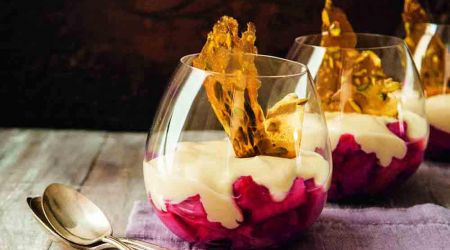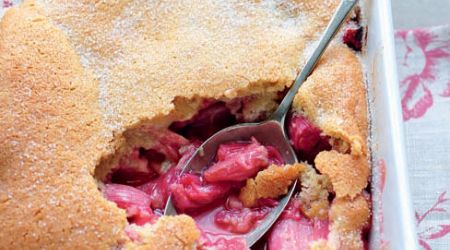Rhubarb
With its vibrant flavours and vivid colours ranging from pale salmon pink to brilliant red, English rhubarb brings a much-needed dose of excitement to the kitchen after the dull days of winter with recipes by Linda Tubby
As winter’s grip begins to loosen, spring is heralded by the persistent rise of rhubarb, bursting from barren fields and gardens, proudly proclaiming the earth’s renewal and the start of the new season. Slender and tender, soft forced rhubarb, with its tightly furled yellow leaves, has been harvested for months already from the darkened hothouses of Yorkshire’s Rhubarb Triangle, but the arrival of outdoor rhubarb, the tarter, heartier and brighter-hued variety, excites the senses of any cook anticipating the vivid colours and fresh flavours of spring.
A vegetable more often thought of as a fruit, at first glance rhubarb is not the most obvious prospect for kitchen delight; its mouth-puckering sourness must be eased with copious amounts of sugar, the vibrantly pink or red stringy flesh softened from its inedible state by cooking. This most English of foods in fact originated in Siberia, where the root of its popularity was not culinary, but in its effectiveness as a cure-all medicine, used as long ago as 2700 BC. Its properties were considered so desirable around the world that by the 16th century the demand for import in Britain – and price – skyrocketed, and rhubarb seeds were brought to the UK for sowing. However, rather than the medicinal rheum palmatum strain, rheum rhaponticum was planted by accident – a variety less suited to treating ailments, but, as the nation’s kitchens quickly discovered, much more palatable. Our culinary love affair with rhubarb had begun.
England’s cold and wet climate is ideal for growing rhubarb. At its height, the Yorkshire Rhubarb Triangle – which stretches between Leeds, Bradford and Wakefield – was the world’s largest producer, and is still known for its forced rhubarb, which is made using a technique developed in the area in the 1800s. Only 11 growers now remain in the Triangle, but with PDO status (protected designation of origin) granted to Yorkshire Rhubarb in 2010, the future looks positive. Janet Oldroyd’s family, owners of E Oldroyd & Sons, has been growing forced and outdoor rhubarb in Yorkshire for five generations, producing 1,300 tonnes annually. ‘The colour varies with variety, but it’s no indication of sweetness,’ Janet says. ‘Rhubarb that is grown in a cooler climate or from an especially red variety like the Stockbridge Arrow will be brighter, but no sweeter than those that are green.’ When buying rhubarb, she suggests you choose firm, umblemished sticks; as soon as you get home, remove any leaves and store in a cool, dark place. ‘Most of the moisture is lost through the leaves, so it will stay fresh for longer this way,’ she says. As for those of us who have rhubarb in our gardens, she cautions to harvest your crop on a dry day; ‘if you harvest in the rain the moisture could split the sticks.’
Rosemary Shrager, chef-patron at Swinton Park’s cooking school, is a great fan of rhubarb: ‘Outdoor rhubarb is wonderful because it holds its shape well – perfect for any dishes where you’ll see the fruit pieces, like tarts. Peel the stalks to get rid of the stringy bits, chop, and cook with about a third sugar to rhubarb ratio; in comparison, you only need about a quarter for the sweeter forced variety. Rhubarb is so versatile and a perfect match for anything fatty, like duck, goose or pork belly, as its sourness cuts through the fat and enhances flavour. Try it with fatty fish like mackerel; I make a salmon confit with rhubarb purée and lentil salad. Ultimately, though, nothing does it like rhubarb ice cream – the creamy sweetness of dairy, when combined with rhubarb’s tartness, makes the ultimate comfort food.’

Recipes
Get Premium access to all the latest content online
Subscribe and view full print editions online... Subscribe


